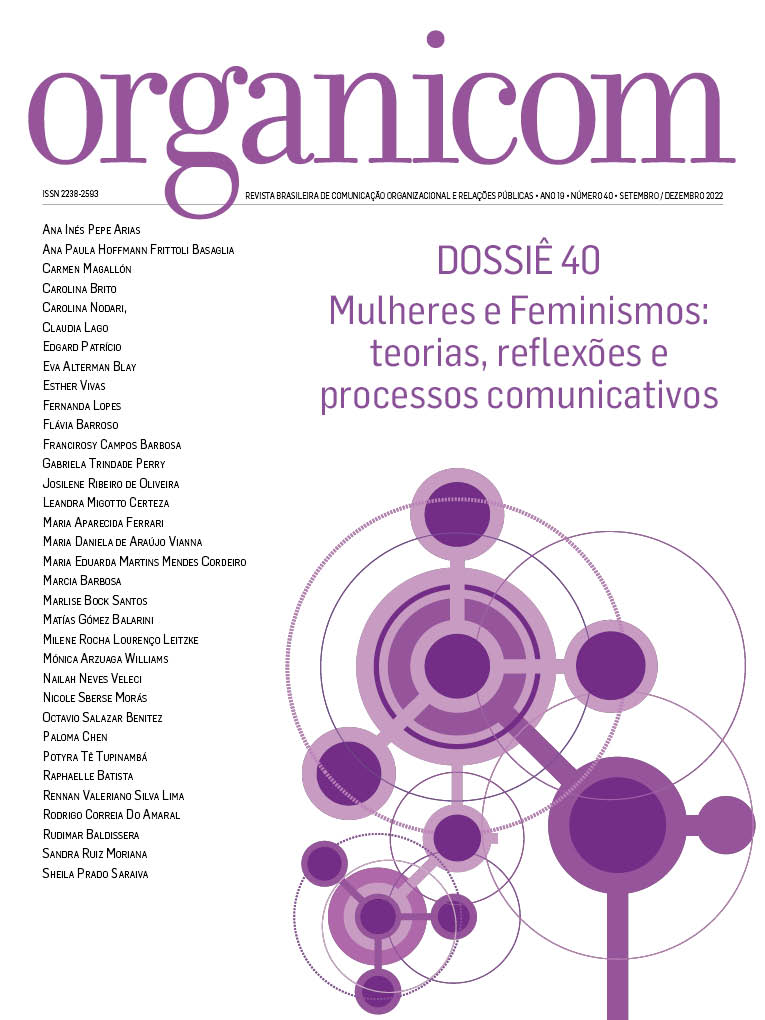O teto de vidro duplo: eles chegaram, mas precisam provar que a comunicação é estratégica
DOI:
https://doi.org/10.11606/issn.2238-2593.organicom.2022.201234Palavras-chave:
Teto de vidro, Equidade de gênero, Comunicação organizacional, Profissionais, UruguaiResumo
Embora o campo da comunicação organizacional no Uruguai seja composto por uma esmagadora maioria de mulheres, metade das unidades de comunicação são lideradas por homens. Os profissionais entrevistados no Monitor de Comunicação da América Latina 2020 indicaram que o teto de vidro os afeta diretamente. Entrevistamos profissionais de ambos os sexos para saber sua percepção e constatamos que a legitimidade do cargo, a homofilia e a cultura social e organizacional são as principais causas desse problema.
Downloads
Referências
ÁLVAREZ-NOBELL, Alejandro et al. Latin American Communication Monitor 2020-2021: comunicación estratégica y relaciones públicas en América Latina: crisis del COVID-19 en la gestión de comunicación, ciberseguridad, situación de las mujeres, retos éticos y nuevas competencias: resultados de una encuesta en 20 países. Bruselas: Euprera; 2021.
ALDOORY, L. A (re)conceived feminist paradigm for public relations: a case for substantial improvement. Journal of Communication, Oxford, v. 55, n. 4, p. 668-684, 2005. doi: https://doi.org/10.1111/j.1460-2466.2005.tb03016.x.
ALDOORY, Linda; TOTH, Elizabeth L. Gender discrepancies in a gendered profession: a developing theory for public relations. Journal of Public Relations Research, Abingdon, v. 14, n. 2, p. 103-126, 2002. doi: https://doi.org/10.1207/S1532754XJPRR1402_2.
ALDOORY, Linda et al. Is it still just a women’s issue? A study of work-life balance among men and women in public relations. Public Relations Journal, Gainesville, v. 2, n. 4, p. 1-20, 2008.
ARZUAGA-WILLIAMS, Mónica. Rol del comunicador organizacional en Uruguay: tareas y funciones. Profesional de la Información, León, v. 29, n. 3, e290326, 2020. doi: https://doi.org/10.3145/epi.2020.may.26.
BATTHYÁNY, Karina; GENTA, Natalia; PERROTTA, Valentina. Uso de licencia parentales y roles de género en el cuidado. Montevideo: Sistema de Cuidados de Uruguay, 2018.
BUZZANELL, Patrice M. Reflections on feminist organizational communication. Management Communication Quarterly, Thousand Oaks, v. 35, n. 1, p. 127-141, 2021. doi: https://doi.org/10.1177/0893318920975211.
BUZZANELL, Patrice M. Reframing the glass ceiling as a socially constructed process: implications for understanding and change. Communication Monographs, Abingdon, v. 62, n. 4, p. 327-354, 1995. doi: https://doi.org/10.1080/03637759509376366.
CHOI, Youjin; HON, Linda Childers. The influence of gender composition in powerful positions on public relations practitioners’ gender-related perceptions. Journal of Public Relations Research, Abingdon, v. 14, n. 3, p. 229-263, 2002. doi: https://doi.org/10.1207/S1532754XJPRR1403_4.
CLINE, Carolyn G. et al. The velvet ghetto: the impact of the increasing percentage of women in public relations and business communication. San Francisco: IABC Foundation; 1986.
FERRARI, Maria Aparecida. Reflexões sobre comunicação organizacional na América Latina: ventos da mudança na gestão da diversidade. Organicom, São Paulo, v. 18, n. 37, p. 23-35, 2021. doi: https://doi.org/10.11606/issn.2238-2593.organicom.2021.188608.
FERRARI, Maria Aparecida; RESTREPO, Sandra Milena Ortega. Historias de vida de relacionistas públicas: maternidad y emprendimiento como opción de trabajo. Revista Latinoamericana de Ciencias de la Comunicación, São Paulo, v. 21, n. 39, p. 208-220, 2022.
GRUNIG, Larissa A.; TOTH, Elizabeth L.; HON, Linda Childers. Women in public relations: how gender influences practice. New York: Guilford Press, 2001.
MENG, Juan; NEILL, Marlene S. Inclusive leadership and women in public relations: defining the meaning, functions, and relationships. Journal of Public Relations Research, Abingdon, v. 33, n. 3, p. 150-167, 2021. doi: https://doi.org/10.1080/1062726X.2021.2010556.
MORENO, Ángeles; FUENTES-LARA, Cristina; KHALIL, Nadia. Brechas y oportunidades de género en la dirección de la comunicación en España. Palabra Clave, Bogotá, v. 25, n. 3, e2535, 2022. doi: https://doi.org/10.5294/pacla.2022.25.3.5.
MORENO, Ángeles; KHALIL, Nadia; TENCH, Ralph. Enemy at the (house) gates: permanence of gender discrimination in public relations career promotion in Latin American. Communication & Society, Pamplona, v. 34, n. 3, p. 169-183, 2021. doi: https://doi.org/10.15581/003.34.3.169-183.
PLACE, Katie R. Power-control or empowerment? How women public relations practitioners make meaning of power. Journal of Public Relations Research, Abingdon, v. 24, n. 5, p. 435-450, 2012. doi: https://doi.org/10.1080/1062726X.2012.723278.
POMPPER, Donnalyn. On social capital and diversity in a feminized industry: further developing a theory of internal public relations. Journal of Public Relations Research, Abingdon, v. 24, n. 1, p. 86-103, 2012. doi: https://doi.org/10.1080/1062726X.2012.626137.
SHA, Bey-Ling; TOTH, Elizabeth L. Future professionals’ perceptions of work, life, and gender issues in public relations. Public Relations Review, Amsterdam, v. 31, n. 1, p. 93-99, 2005. doi: https://doi.org/10.1016/j.pubrev.2004.09.004.
TOPIC, Martina; TENCH, Ralph. Women in public relations: a thematic analysis of ECM data (2009-2019). In: THEOFILOU, Anastasios (ed.). Women in PR history. London: Routledge, 2020. p. 18-30.
TOTH, Elizabeth L. Making peace with gender issues in public relations. Public Relations Review, Amsterdam, v. 14, n. 3, p. 36-47, 1988. doi: https://doi.org/10.1016/S0363-8111(88)80046-8.
TOTH, Elizabeth L.; CLINE, Carolyn G. Public relations practitioner attitudes toward gender issues: a benchmark study. Public Relations Review, Amsterdam, v. 17, n. 2, p. 161-174, 1991. doi: https://doi.org/10.1016/0363-8111(91)90053-N.
VARDEMAN-WINTER, Jennifer; PLACE, Katie R. Still a lily-white field of women: the state of workforce diversity in public relations practice and research. Public Relations Review, Amsterdam, v. 43, n. 2, p. 326-336, 2017. doi: https://doi.org/10.1016/j.pubrev.2017.01.004.
WRIGHT, Donald K. et al. Under the glass ceiling: an analysis of gender issues in American public relations. New York: Public Relations Society of America Foundation, 1991. (Monograph Series, v. 1, n. 2).
Downloads
Publicado
Edição
Seção
Licença
Copyright (c) 2022 Ana Inés Pepe Arias, Mónica Arzuaga Williams, Matías Gómez Balarini

Este trabalho está licenciado sob uma licença Creative Commons Attribution-NonCommercial-ShareAlike 4.0 International License.
A submissão implica a cessão de direitos da primeira publicação à revista Organicom, sem pagamento. Os autores podem estabelecer por separado acordos adicionais para a distribuição não exclusiva de versão da obra publicada na revista (como colocar em um repositório institucional ou publicar um livro), com o devido reconhecimento de sua publicação inicial na revista Organicom.


